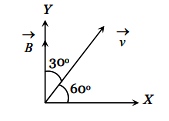
A proton of mass \[1.67 \times {10^{ - 27}}\;kg\] and charge \[1.68 \times {10^{ - 19}}\;C\] is projected with a speed of \[2 \times {10^6}m/s\;\]at an angle of \[{60^o}\]to the \[X\]−axis. If a uniform magnetic field of \[0.10\;T\] is applied along \[Y\]−axis, the path of the proton is
A. a circle of radius \[0.2m\] and time period \[\pi \times {10^{ - 7}}\;s\]
B. a circle of radius \[0.1m\] and time period \[2\pi \times {10^{ - 7}}\;s\]
C. a helix of radius \[0.1m\] and time period \[2\pi \times {10^{ - 7}}\;s\]
D. a helix of radius \[0.2m\] and time period \[4\pi \times {10^{ - 7}}\;s\]
Answer
221.1k+ views
Hint: In the given question, we need to determine the path of a proton. That means we need to find the radius of the circular path and the time period of the particle moving along a circular path. For this, we need to use the following formulae for radius and time period to get the desired result.
Formula used:
The following formulae are used to solve the given question.
The radius of circular path of charged particle is \[r = \dfrac{{mv\sin \theta }}{{qB}}\].
Here, \[r\] indicates the radius of curvature of the path of a charged particle with mass \[m\] as well as charge \[q\] travelling at a speed \[v\] perpendicular to a magnetic field of intensity \[B\].
Also, the time period is \[T = \dfrac{{2\pi m}}{{qB}}\]
Here, \[T\] is the time period.
Complete answer:
Consider the following figure.

Image: Angle between magnetic field of intensity and velocity
We know that the radius of circular path of charged particle is \[r = \dfrac{{mv\sin \theta }}{{qB}}\]
But \[m = 1.67 \times {10^{ - 27}}\;kg,v = 2 \times {10^6}m/s\;,q = 1.68 \times {10^{ - 19}}\;C,\theta = {30^o},\] and \[B = 0.10\;T\]
This gives, \[r = \dfrac{{1.67 \times {{10}^{ - 27}}\; \times 2 \times {{10}^6} \times \sin {{30}^o}}}{{1.68 \times {{10}^{ - 19}} \times 0.10}}\]
By simplifying, we get
\[r = 0.1{\rm{ }}m\]
Also, the time period is given by
\[T = \dfrac{{2\pi m}}{{qB}}\]
But \[m = 1.67 \times {10^{ - 27}}\;kg\;,q = 1.68 \times {10^{ - 19}}\;C,\] and \[B = 0.10\;T\]
So, we get \[T = \dfrac{{2\pi \times 1.67 \times {{10}^{ - 27}}}}{{1.68 \times {{10}^{ - 19}} \times 0.10}}\]
By solving, we get
\[T = 2\pi \times {10^{ - 7}}{\rm{ S}}\]
Hence, the path of proton is a circular of radius \[0.1{\rm{ }}m\] and time period \[2\pi \times {10^{ - 7}}\;s\].
Therefore, the correct option is (B).
Note:Many students make mistake in simplification part. That means, they may get wrong while calculating the power of ten. Also, it is necessary to use diagrammatic representation to illustrate the given condition.
Formula used:
The following formulae are used to solve the given question.
The radius of circular path of charged particle is \[r = \dfrac{{mv\sin \theta }}{{qB}}\].
Here, \[r\] indicates the radius of curvature of the path of a charged particle with mass \[m\] as well as charge \[q\] travelling at a speed \[v\] perpendicular to a magnetic field of intensity \[B\].
Also, the time period is \[T = \dfrac{{2\pi m}}{{qB}}\]
Here, \[T\] is the time period.
Complete answer:
Consider the following figure.

Image: Angle between magnetic field of intensity and velocity
We know that the radius of circular path of charged particle is \[r = \dfrac{{mv\sin \theta }}{{qB}}\]
But \[m = 1.67 \times {10^{ - 27}}\;kg,v = 2 \times {10^6}m/s\;,q = 1.68 \times {10^{ - 19}}\;C,\theta = {30^o},\] and \[B = 0.10\;T\]
This gives, \[r = \dfrac{{1.67 \times {{10}^{ - 27}}\; \times 2 \times {{10}^6} \times \sin {{30}^o}}}{{1.68 \times {{10}^{ - 19}} \times 0.10}}\]
By simplifying, we get
\[r = 0.1{\rm{ }}m\]
Also, the time period is given by
\[T = \dfrac{{2\pi m}}{{qB}}\]
But \[m = 1.67 \times {10^{ - 27}}\;kg\;,q = 1.68 \times {10^{ - 19}}\;C,\] and \[B = 0.10\;T\]
So, we get \[T = \dfrac{{2\pi \times 1.67 \times {{10}^{ - 27}}}}{{1.68 \times {{10}^{ - 19}} \times 0.10}}\]
By solving, we get
\[T = 2\pi \times {10^{ - 7}}{\rm{ S}}\]
Hence, the path of proton is a circular of radius \[0.1{\rm{ }}m\] and time period \[2\pi \times {10^{ - 7}}\;s\].
Therefore, the correct option is (B).
Note:Many students make mistake in simplification part. That means, they may get wrong while calculating the power of ten. Also, it is necessary to use diagrammatic representation to illustrate the given condition.
Recently Updated Pages
[Awaiting input: Please provide the content from "Ask AI Response," "Competitor 1," and "Competitor 2," so I can perform the analysis and synthesize the requested metadata and headings.]

Young’s Double Slit Experiment Derivation Explained

A square frame of side 10 cm and a long straight wire class 12 physics JEE_Main

The work done in slowly moving an electron of charge class 12 physics JEE_Main

Two identical charged spheres suspended from a common class 12 physics JEE_Main

According to Bohrs theory the timeaveraged magnetic class 12 physics JEE_Main

Trending doubts
JEE Main 2026: Application Form Open, Exam Dates, Syllabus, Eligibility & Question Papers

Derivation of Equation of Trajectory Explained for Students

Hybridisation in Chemistry – Concept, Types & Applications

Understanding the Angle of Deviation in a Prism

How to Convert a Galvanometer into an Ammeter or Voltmeter

Degree of Dissociation: Meaning, Formula, Calculation & Uses

Other Pages
JEE Advanced Marks vs Ranks 2025: Understanding Category-wise Qualifying Marks and Previous Year Cut-offs

Dual Nature of Radiation and Matter Class 12 Physics Chapter 11 CBSE Notes - 2025-26

Ideal and Non-Ideal Solutions Explained for Class 12 Chemistry

Understanding the Electric Field of a Uniformly Charged Ring

Understanding Atomic Structure for Beginners

Understanding Electromagnetic Waves and Their Importance




